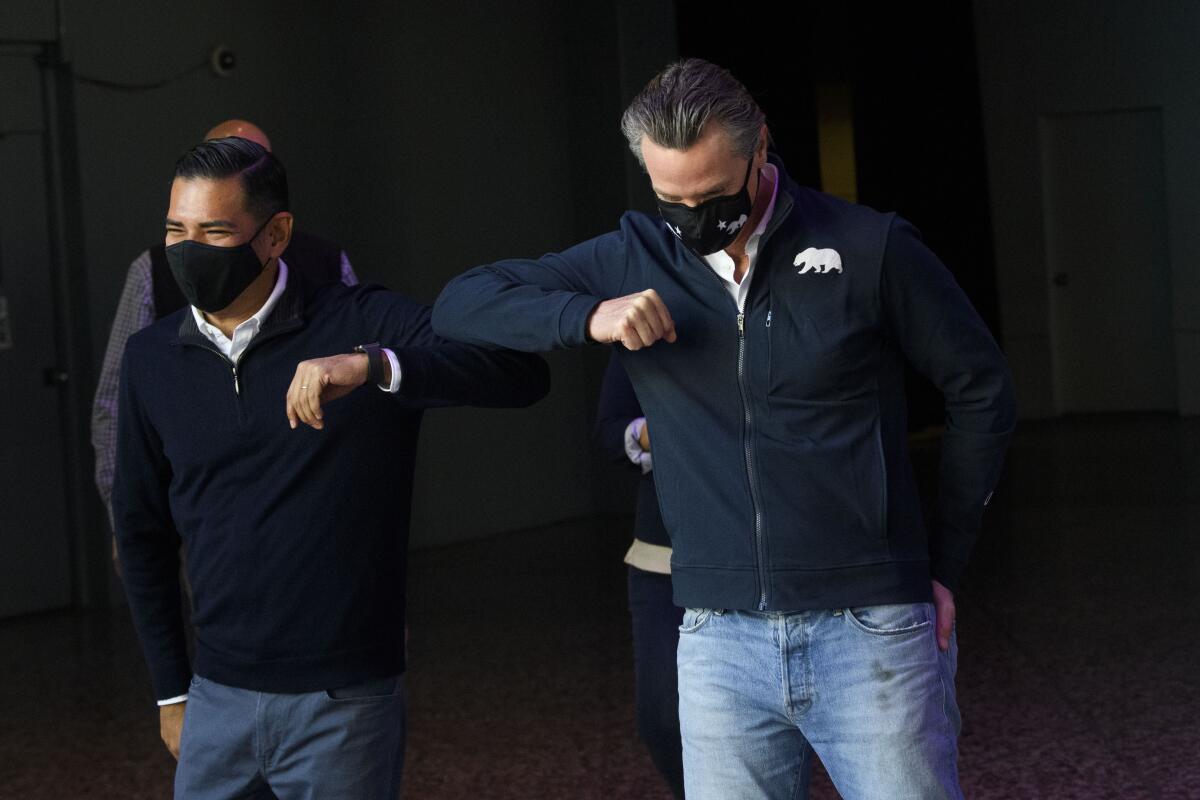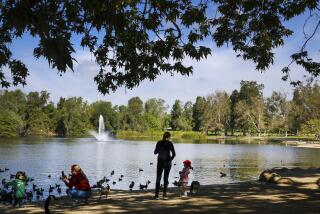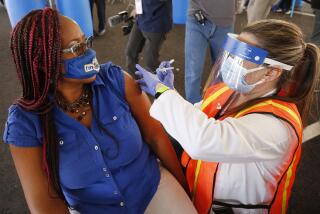Newsom touts Long Beach as model for COVID-19 vaccinations, schools reopening

- Share via
Despite wavering supplies and glaring racial and geographic inequities plaguing Los Angeles County’s COVID-19 vaccination rollout, Gov. Gavin Newsom on Monday praised the region’s distribution efforts and touted the city of Long Beach as a model for the rest of the state.
Speaking from a vaccination site at the Long Beach Convention Center, Newsom vowed to press forward with plans to vaccinate educators, reopen schools and refocus on hard-hit communities.
Long Beach, which has its own public health department, separate from L.A. County’s, began vaccinating teachers in January and has announced plans to reopen schools for its youngest students March 29.
“I want to encourage that to be replicated all throughout the state of California,” Newsom said, noting that vaccinating teachers and getting kids back into schools are essential to reopening the economy.
On Friday, he announced that the state is setting aside 10% of first doses of vaccine it receives for educators and child-care workers.
“We’re moving in that direction with clarity, with determination,” he said.
In addition to educators, Long Beach last month began vaccinating food and grocery store workers, along with healthcare workers, firefighters, police officers and “100% of its nursing home residents,” Mayor Robert Garcia said Monday.
South and East L.A., parts of the San Gabriel and San Fernando valleys, areas near the L.A. and Long Beach ports and the Antelope Valley have the lowest vaccination rates.
The state is administering an average of nearly 200,000 doses each day and will be close to providing 7.5 million people with at least one dose by the end of Monday, the governor said.
But there is not enough supply to vaccinate everyone who is eligible. California receives, on average, about 1.3 million doses per week, Newsom said, but has the capacity to build out a system that could administer as many as 4 million per week.
“Sites all across the state of California are toggling back based upon limited supply,” he said, adding that the Long Beach site is running at about one-third of its capacity. “That’s a manufacturing issue.… It’s simply not what we’re capable of administering, meaning we can do exponentially more.”
Adding to supply concerns were delivery issues caused by inclement weather across the nation. The main manufacturing sites for vaccine producers Moderna and Pfizer-BioNTech are in Massachusetts and Michigan, respectively; at least two scheduled shipments did not make it to L.A. last week. City-run sites that were forced to close amid the delays are slated to reopen Tuesday.
Despite the uneven rollout, Newsom said California is in a “much better place” as the number of coronavirus cases continues to drop. Case rates plunged from 8% a month ago to 3% on Monday, a figure not seen since Nov. 1. Hospitalizations and intensive care unit admissions are down 41% and 39%, respectively, over the last two weeks.
Many other pandemic indicators continue to dramatically improve, according to a Times analysis. California is recording about 7,000 new coronavirus cases a day, down from 45,000 six weeks ago. The state recorded 327 COVID-19 deaths a day over the last week, down from the peak of 562 for the week that ended Jan. 27.
Experts say about most Americans will need to be vaccinated to bring the coronavirus pandemic under control. Track California’s progress toward that goal.
In terms of vaccinations, not all parts of L.A. County are running as smoothly as Long Beach. According to The Times’ vaccination tracker, only 12% of L.A. County’s 10 million residents have been vaccinated, with some areas faring better than others.
In South Los Angeles and Compton, for example, only 5% of residents have been vaccinated, compared with 25% of residents in Beverly Hills. L.A. County Public Health Director Barbara Ferrer addressed the inequities in a briefing Monday and apologized to communities that have had limited access to vaccine.
“We have and do extend our apologies,” she said. “It’s not about talk at this point, though. It’s really about shifting the ability of us to make sure that we’re improving access in those communities.”
Newsom on Monday similarly doubled down on his promise to support efforts that “advance the cause of equity” and “make sure that we are meeting people where they are, including public housing sites.”
“In the aggregate, as a state, we’re not close to where we need to be in terms of meeting our equity targets,” he said. “We need to own that.”
The inequities go beyond county lines. After leaving Long Beach, Newsom headed to Kern County, which is also struggling with limited vaccine supplies. Bakersfield Mayor Karen Goh said the county is prepared to administer up to 5,000 vaccinations a day but is administering only 800 because of shortages.
“What do we need? We need vaccines,” she said.
In response, Newsom said the state will be increasing the allocation of vaccine to the Central Valley by 58%; it will increase allocation to Kern County by 78%. The state this week will also redirect 34,000 doses from large pharmacies and create 11 mobile sites to help address demand in the area.
“As we broaden the tiers and we apply more critical workforce — farmworkers, food workers and other critical workers like teachers — we obviously will be able to do more to advance that cause of equity,” Newsom said. “It’s been the cause that has brought me almost to every part of the state.”
In addition to launching a dashboard to monitor vaccine distribution, the state awarded grants to more than 100 community-based organizations to advance outreach, education and organization efforts and to identify sites for pop-up and mobile vaccination operations, the governor said.
The state also partnered with President Biden’s administration to launch two large-scale vaccination sites that will be run jointly with the Federal Emergency Management Agency, including a site at Cal State Los Angeles, to help reach underserved communities.
There is still much work to be done. According to The Times’ COVID-19 vaccination tracker, fewer than 14% of California’s roughly 40 million people have received a shot.
More to Read
Sign up for Essential California
The most important California stories and recommendations in your inbox every morning.
You may occasionally receive promotional content from the Los Angeles Times.














